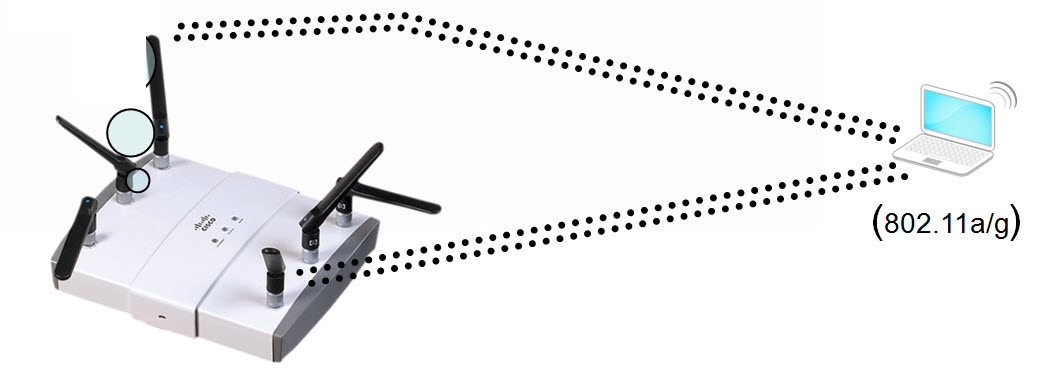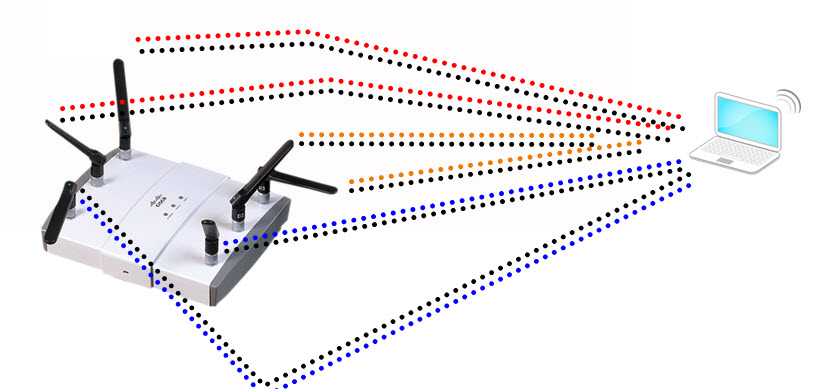Beamforming: The Best WiFi You’ve Never Seen
The Client That Could Be
Ever since the days when 802.11a/g grew a second antenna, we’ve had “transmit/receive diversity,” which sends the same data stream out over multiple antennas and simply lets the access point select whichever antenna is receiving the best signal. Applied to 802.11n, transmit diversity used multiple antennas to help increase range and better deal with difficult locations. This is why 11n does a generally better job than 11a/g at eliminating dead spots.
However, 802.11n equipment got another jump in intelligence with the addition of maximal ratio combining (MRC). This technology combines multiple antenna signals in such a way that strong signals are multiplied while weak signals are attenuated. The signals you want get boosted, while those you don’t have their power cut. MRC is built into all 802.11n chips.
Now, as you might expect, the receiving end can play an important role in optimizing chip-based beamforming. With 802.11a/g, access points could listen to the client and use rudimentary MRC analysis to boost power along the best-suited beam, providing a gain of roughly 1 to 2 dB. The catch here is that the access point was doing all the work. There was no active feedback coming from the 802.11a/g clients.

With “implicit beamforming,” wherein an 802.11n AP is communicating with 802.11n clients, you can have some feedback. Rather than having the access point perform all of the signal analysis, it can query the client and see if it agrees that this or that particular beam orientation is optimal. Having this limited two-way communication yields a maximum of 3 dB additional gain, but the bad news is that there are currently no products on today’s market supporting implicit beamforming.
With “explicit beamforming,” feedback between the AP and client happens much more frequently. This way, if a client moves or an antenna gets adjusted or anything happens to alter the dynamics of the signal strengths, the system is able to adapt almost instantaneously to a new, optimized configuration. Again, having the client involved in this way can yield up to a 3 dB benefit with two radios, but there are no products available today offering this capability. Hopefully this will change.

Get Tom's Hardware's best news and in-depth reviews, straight to your inbox.
Current page: The Client That Could Be
Prev Page Inside On-Chip Phased Arrays Next Page On-Chip Challenges-
pirateboy just what we need, more retarded failnoobs clogging up the airwaves with useless braindead movieclips...yaayReply -
bucifer This article started up pretty good with lots of technical data and the beamforming technology in theory but after that the goodness stopped.Reply
1.You cannot compare two products by testing them with a in-house developed software. It's like testing ATI vs nVIDIA with nvidia made benchmark.
2.If you do something get it done, don't just go with half measures. I don't care if you didn't have time. You should have planned this from the beginning. The tests are incomplete, and the article is filled with crap of Rukus and Cisco. -
Mr_Man In defense of your wife, you didn't HAVE to use that particular channel to view all the "detail".Reply -
@Mr_Man: With a name like yours, I'd think that you'd sympathize with Chris a bit more :P Unless (Mr_Man == I likes men) :DReply
-
Pei-chen Both Tyra and Heidi have personal issues and would be pretty difficult friend/mate.Reply
The network idea sounds better. I couldn’t get my 10 feet g network to transmit a tenth as much as my wired network without it dropping.
-
zak_mckraken There's one question that I think was not covered by the article. Can a beamformaing AP can sustain the above numbers on two different clients? Let's say we take the UDP test at 5 GHz. The result shows 7.3 Mb/s. If we had two clients at opposite sides of the AP doing the same test, would we have 7.3 Mb/s for each test or would the bandwidth be sliced in 2?Reply
The numbers so far are astonishing, but are they realistic in a multi-client environnement? That's something I'd like to know!